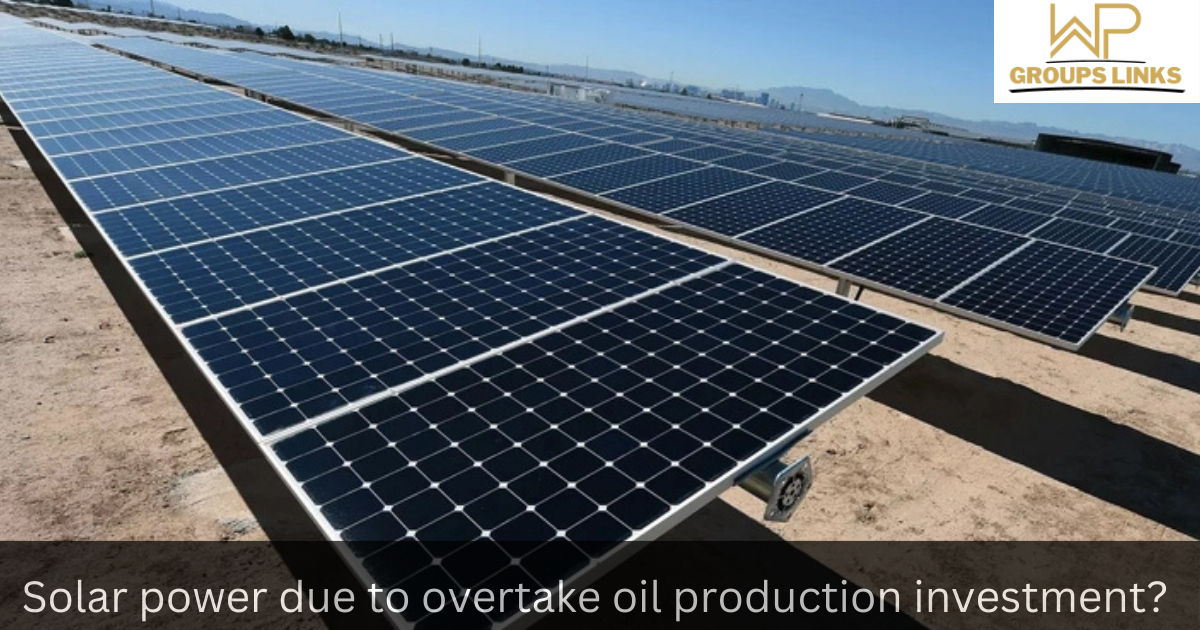Solar Power
Solar power is posing a significant threat to the hegemony of fossil fuels, notably oil, as the globe struggles with the pressing need to switch to renewable and environmentally friendly energy sources. Solar energy has grown significantly more technologically advanced in recent years, spurring a boom in investment and implementation. This article examines how solar energy is positioned to surpass investments in oil production, ushering in a revolution in renewable energy that promises a greener, more sustainable future.
The Rise of Solar Power
Solar power has witnessed an extraordinary rise in popularity and viability over the past decade. Technological advancements, coupled with declining costs, have fueled this growth, making solar energy more accessible and economically viable. The declining price of solar panels, improved efficiency rates, and innovative storage solutions have positioned solar power as a formidable contender against conventional energy sources.
Solar Power Investment
Investment in solar energy has been rising quickly, a sign of increased optimism about its possibilities. Solar energy initiatives are receiving a lot of funding from governments, businesses, and people. The International Energy Agency, also known as the IEA, reports that global investment in solar energy has overtaken that in all other forms of energy, including oil. Environmental concerns, governmental incentives, and the potential long-term economic advantages of solar power are a few of the elements that are causing this trend.
Environmental Imperative
The urgency to address climate change and reduce greenhouse gas emissions has become a global priority. Solar power provides an environmentally friendly alternative to fossil fuels, as it generates electricity without releasing harmful pollutants or greenhouse gases. Governments and international organizations are increasingly recognizing the need to transition to renewable energy sources, with solar power playing a pivotal role in achieving ambitious emissions reduction targets.
Economic Advantages of Solar Power
Both the environment and the economy gain greatly from the use of solar energy. Solar energy is becoming more and more affordable because to governmental backing, incentives, and the falling costs of rooftop solar panels and related technology. Additionally, solar power plants have a long lifetime and require little upkeep, which over time lowers running expenses. Solar energy is becoming into a desirable investment choice with potential for long-term financial gains as efficiencies of scale continue to drive down prices.
Technological innovations
Technological innovations have played a crucial role in the rapid growth and increasing viability of solar power. Breakthroughs in solar cell efficiency, energy storage, and new applications have expanded the potential of solar energy. This section explores the key technological advancements that are driving the solar power revolution.
High-Efficiency Solar Cells
The efficiency of turning sunlight into power has substantially increased because to developments in solar cell technology. Thin-film and perovskite solar cells, which are more effective than conventional silicon-based solar cells, are replacing or improving them. Particularly in terms of efficiency, perovskite solar cells have made amazing strides, coming close to silicon-based cell values. Solar energy is becoming more widely available and commercially feasible because to the flexible, cost-effective production processes, greater conversion rates, and next-generation solar cells.
Energy Storage Solutions
One of the challenges for solar power has been the erratic quality of sunlight. However, innovative energy storage methods have been created to address this issue. Battery technology, such as lithium-ion batteries, is being incorporated into solar power systems to store additional energy for use during periods of low sunlight or high demand. Developments in flow batteries, thermal electricity storage, and storage for hydrogen, all of which are now being explored, will further increase the reliability and adaptability of solar power.
Beyond Rooftop Installations
The concept of solar power has expanded beyond traditional rooftop installations. Solar farms, also known as photovoltaic power stations, are large-scale arrays of solar panels that can generate significant amounts of electricity. These solar farms take advantage of vast open spaces, including deserts and unused land, to harness solar energy on a larger scale. Additionally, floating solar arrays are gaining popularity, particularly on bodies of water such as reservoirs and lakes. These floating platforms accommodate solar panels and benefit from the cooling effect of the water, leading to increased efficiency.
Integration into Everyday Infrastructure
Innovative concepts are emerging to integrate solar power into everyday infrastructure. Solar windows, for example, incorporate transparent solar cells into windows, allowing them to generate electricity while still serving their primary function. This technology holds promise for commercial buildings and urban environments where window surfaces are abundant. Another exciting development is solar paint, which consists of photovoltaic particles that can be applied to surfaces, transforming them into solar energy generators. This opens up possibilities for solar power integration in various structures like houses, buildings, and even vehicles.
Integration of the Internet of Things (IoT) with the Smart Grid
Solar power system optimization depends heavily on Internet of Things (IoT) and smart grid technology. Solar panel performance, energy output, and consumption data may be gathered in real-time via IoT-enabled sensors as well as tracking tools. Predictive maintenance, effective energy resource management, and the capacity to adapt to changing circumstances are all made possible by this data. Smart grids provide greater coordination between energy output, storage, and consumption and guarantee the best use of renewable energy sources by facilitating the incorporation of solar power into already-existing electrical infrastructures.



